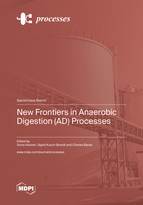New Frontiers in Anaerobic Digestion (AD) Processes
A special issue of Processes (ISSN 2227-9717). This special issue belongs to the section "Environmental and Green Processes".
Deadline for manuscript submissions: closed (18 December 2022) | Viewed by 44999
Special Issue Editors
Interests: optimised process configurations and operating regimes for renewable energy production through anaerobic digestion; biomass production for biorefineries; valorisation of food waste; algal biomass systems; membrane bioreactors; bioprocessing of biodegradable municipal waste; industrial wastewaters
Interests: biological process engineering; anaerobic digestion (biogas); organic resources; food waste; circular economy; solid waste management; environmental engineering; environmental sustainability
Special Issues, Collections and Topics in MDPI journals
Interests: innovative technology for environmental protection; controlled anaerobic and aerobic biodegradation of municipal and industrial solid wastes; treatment of liquid industrial effluents by biological systems; energy production from digestion of crops and agricultural wastes; development of operating protocols for anaerobic digestion to maximise rates of substrate conversion and biogas yield
Special Issue Information
Dear Colleagues,
Anaerobic digestion (AD) is widely used to process a variety of organic materials, but a major share of its full potential currently remains unlocked.
This Special Issue on “New Frontiers in Anaerobic Digestion (AD) Processes” seeks original contributions that focus on recent developments and advanced concepts related to the valorisation of biomass under application of anaerobic digestion. Topics of interest include, but are not limited to:
- optimised operating regimes for AD processes;
- novel or significantly improved reactor configurations;
- progress in overcoming process inhibitions and ensuring process stability;
- modelling and control strategies;
- valorisation of biogas components in high-value applications;
- integrating AD into biorefinery concepts;
- integrating AD and renewables in power-to-gas applications;
- synergistic integration of AD into chemical and biochemical processes;
- AD process integration at the industrial scale; and
- sustainable concepts for decentralised, small-scale AD processes.
Prof. Dr. Sonia Heaven
Dr. Sigrid Kusch-Brandt
Prof. Dr. Charles Banks
Guest Editors
Manuscript Submission Information
Manuscripts should be submitted online at www.mdpi.com by registering and logging in to this website. Once you are registered, click here to go to the submission form. Manuscripts can be submitted until the deadline. All submissions that pass pre-check are peer-reviewed. Accepted papers will be published continuously in the journal (as soon as accepted) and will be listed together on the special issue website. Research articles, review articles as well as short communications are invited. For planned papers, a title and short abstract (about 100 words) can be sent to the Editorial Office for announcement on this website.
Submitted manuscripts should not have been published previously, nor be under consideration for publication elsewhere (except conference proceedings papers). All manuscripts are thoroughly refereed through a single-blind peer-review process. A guide for authors and other relevant information for submission of manuscripts is available on the Instructions for Authors page. Processes is an international peer-reviewed open access monthly journal published by MDPI.
Please visit the Instructions for Authors page before submitting a manuscript. The Article Processing Charge (APC) for publication in this open access journal is 2400 CHF (Swiss Francs). Submitted papers should be well formatted and use good English. Authors may use MDPI's English editing service prior to publication or during author revisions.
Keywords
- operating regimes and reactor configuration for anaerobic digestion processes
- modelling and control
- process inhibition and stability
- biorefinery concepts
- integration with other processes and renewables
- large and small-scale applications
- biogas production







